 Maritime Silk Road Luxuries of the Han Dynasty
Maritime Silk Road Luxuries of the Han Dynasty
 Ceremony in honor of Confucius held in Sichuan
Ceremony in honor of Confucius held in Sichuan
 Hollywood blockbusters heats up fashion show in NW China
Hollywood blockbusters heats up fashion show in NW China
 Ciao! Chinese beauties!
Ciao! Chinese beauties!
 Naughty polar bear waves to photographer in Wapusk, Canada
Naughty polar bear waves to photographer in Wapusk, Canada
 An eye feast: BFA freshmen registration
An eye feast: BFA freshmen registration
 Top 10 most lavish weddings
Top 10 most lavish weddings
 Most amazing chi-pao beauties
Most amazing chi-pao beauties
 Observe the earth from space
Observe the earth from space
 Chinese lingerie brand arrives in Las Vegas
Chinese lingerie brand arrives in Las Vegas
Rome, August 26 - Marc Chagall's largest-everretrospective in Italy will open on September 17 at Milan'sPalazzo Reale.
The exhibit 'Marc Chagall. A retrospective 1908-1985' runsthrough February 1, 2015.
Over 220 masterworks from international public and privatecollections will be showcased at the exhibit, which will alsopresent an unpublished autobiography of the Russian artistrecently discovered in the Parisian archives of Marc anddaughter Ida Chagall.
In the autobiography, Chagall (1887-1985) unveilsinteresting details about his life like his squabbles with PabloPicasso, pays tribute to Claude Monet's painting, describes hisadmiration for Pierre Bonnard and his first touching trip to the''Jewish land'', saying among other things that ''beyond thelandscape'', he could perceive the prophets next to him. He also talks about a variety of issues ranging from thenatural beauty of Nice to political and religious opinions.
The show is promoted by the city of Milan - as part of theprogramme 'Milan heart of Europe' - and is organized andproduced by Palazzo Reale, 24 Ore Cultura of the 24 Ore Group,the Arthemisia Group and Gamm Giunti.
Claudia Zevi has curated the exhibit in cooperation withMeret Meyer with the aim of presenting a thorough insight intothe artist's vast production, from his first painting 'Le petitsalon', until his last monumental works dating back to the1980s.
The exhibition documents, thanks to its vast andhigh-quality selection of works, Chagall's rare ability toremain true to his poetry throughout a prolific career, whichmakes his art immediately recognizable though he was very closeto early-20th century avant-garde movements like Fauvism andCubism.
Masterworks on show - including oil paintings, watercoloursand pastels - have been loaned by leading museums including theMuseum of Modern Art and Metropolitan in New York, Washington'sNational Gallery, the Russian Museum in Saint Petersburg and theCentre Pompidou in Paris, and hail from a total of over 50public and private collections.
Organized chronologically, the show gives an insight intothe way the artist worked his way through different culturalroots - his Jewish Hasidic upbringing, Russian heritage andwestern art movements which saw the light at the beginning ofthe 20th century in Paris - to hone his unique style.
The show opens with Chagall's first works in Russia andcontinues with his first stay in France and subsequent trip backhome in 1921.
Chagall's autobiography, to be presented at the show,describes the moment he leaves Russia for good and starts hissecond exile, first in France and then, in the 1940s, in the US,where his beloved wife Bella died.
The exhibit then shows how Chagall's poetry took on thecolours and relaxed atmosphere of southern France once hereturned to Europe and decided to move to the Cote d'Azur.
Works including The birthday, Jew in Bright Red, The Walk,The Poet Reclining, Double Portrait, Cow with Umbrella, TheBlack Glove, The Madonna of the Village, and Yellow Crucifixionshow how Chagall was able to communicate joy and confidence in abetter world in spite of his exile and the hardships heexperienced, through a unique artistic language he had honed byassimilating his three different heritages. Born to a Hasidic family in Vitebsk, Belarus, his mysticismcan be traced back to his Jewish roots, while his homelandinspired his depiction of folk symbols. He drew from Dutch painter Rembrandt, as well as fromcontemporary avant-garde artists in Paris, though the sense ofwonder towards nature can be traced back to Medieval art ratherthan 20th century movements.
The flowers and animals he so often portrayed enabled himto overcome a Jewish ban on depicting human figures while hetransformed them, citing Russian Medieval culture, into ametaphor of a universe in which humans could finally live inpeace.
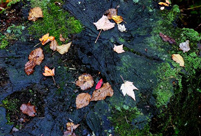 Appreciating red leaves in early autumn
Appreciating red leaves in early autumn Apple introduces larger iPhones, new watch
Apple introduces larger iPhones, new watch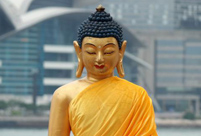 Chinese Buddhist Canon blesses Hong Kong
Chinese Buddhist Canon blesses Hong Kong Beautiful postgraduate teaches in remote area
Beautiful postgraduate teaches in remote area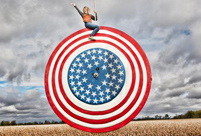 Amazing Guinness World Records
Amazing Guinness World Records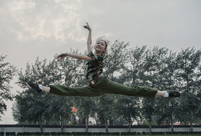 Freshmen of Beijing Dance Academy take military training
Freshmen of Beijing Dance Academy take military training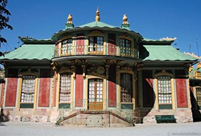 Chinoiserie architectures overseas
Chinoiserie architectures overseas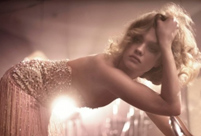 Top 10 world's highest-paid models 2014
Top 10 world's highest-paid models 2014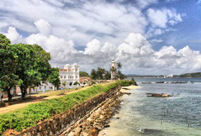 Following the step of Zheng He
Following the step of Zheng He Artistic gymnastics performance
Artistic gymnastics performance Moon of Mid-autumn Festival
Moon of Mid-autumn Festival Peace Mission 2014 joint military drill
Peace Mission 2014 joint military drill I want to be on stage at the Spring Festival Gala
I want to be on stage at the Spring Festival Gala Sand painting world
Sand painting world COMAC jumbo jet and its global rivals
COMAC jumbo jet and its global rivalsDay|Week|Month